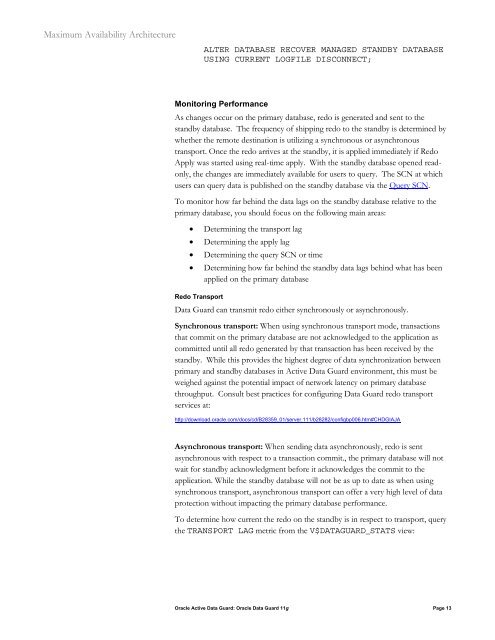MAA - Oracle 10gR2 Redo Transport and Network Best Practices
MAA - Oracle 10gR2 Redo Transport and Network Best Practices
MAA - Oracle 10gR2 Redo Transport and Network Best Practices
Create successful ePaper yourself
Turn your PDF publications into a flip-book with our unique Google optimized e-Paper software.
Maximum Availability Architecture<br />
ALTER DATABASE RECOVER MANAGED STANDBY DATABASE<br />
USING CURRENT LOGFILE DISCONNECT;<br />
Monitoring Performance<br />
As changes occur on the primary database, redo is generated <strong>and</strong> sent to the<br />
st<strong>and</strong>by database. The frequency of shipping redo to the st<strong>and</strong>by is determined by<br />
whether the remote destination is utilizing a synchronous or asynchronous<br />
transport. Once the redo arrives at the st<strong>and</strong>by, it is applied immediately if <strong>Redo</strong><br />
Apply was started using real-time apply. With the st<strong>and</strong>by database opened readonly,<br />
the changes are immediately available for users to query. The SCN at which<br />
users can query data is published on the st<strong>and</strong>by database via the Query SCN.<br />
To monitor how far behind the data lags on the st<strong>and</strong>by database relative to the<br />
primary database, you should focus on the following main areas:<br />
• Determining the transport lag<br />
• Determining the apply lag<br />
• Determining the query SCN or time<br />
• Determining how far behind the st<strong>and</strong>by data lags behind what has been<br />
applied on the primary database<br />
<strong>Redo</strong> <strong>Transport</strong><br />
Data Guard can transmit redo either synchronously or asynchronously.<br />
Synchronous transport: When using synchronous transport mode, transactions<br />
that commit on the primary database are not acknowledged to the application as<br />
committed until all redo generated by that transaction has been received by the<br />
st<strong>and</strong>by. While this provides the highest degree of data synchronization between<br />
primary <strong>and</strong> st<strong>and</strong>by databases in Active Data Guard environment, this must be<br />
weighed against the potential impact of network latency on primary database<br />
throughput. Consult best practices for configuring Data Guard redo transport<br />
services at:<br />
http://download.oracle.com/docs/cd/B28359_01/server.111/b28282/configbp006.htm#CHDGIAJA<br />
Asynchronous transport: When sending data asynchronously, redo is sent<br />
asynchronous with respect to a transaction commit., the primary database will not<br />
wait for st<strong>and</strong>by acknowledgment before it acknowledges the commit to the<br />
application. While the st<strong>and</strong>by database will not be as up to date as when using<br />
synchronous transport, asynchronous transport can offer a very high level of data<br />
protection without impacting the primary database performance.<br />
To determine how current the redo on the st<strong>and</strong>by is in respect to transport, query<br />
the TRANSPORT LAG metric from the V$DATAGUARD_STATS view:<br />
<strong>Oracle</strong> Active Data Guard: <strong>Oracle</strong> Data Guard 11g Page 13

















